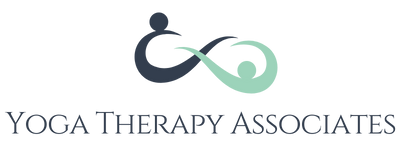By Christine Saari, MA, E-RYT, C-IAYT
Clinicians are beginning to recommend breathwork as a complement to traditional mental health care such as talk therapy and medication.
The terms “breathwork” and “pranayama” are used here synonymously to refer to breathing techniques or any practice of mindful controlled breathing intended to induce a therapeutic effect or to treat a health condition.
Breath practices have traditional origins in Yoga and Chinese medicine, and have branched into a wide variety of modern breathing practices. These include Yogic pranayamas like alternate nostril breathing, and Western practices like the Wim Hoff method and holotropic or conscious connected breathwork. Some of the more well-known breath techniques practiced at home include diaphragmatic breathing, box breathing, the 4-7-8 breath, deep breathing, and mindful breathing.
When offering breath instruction in session with clients, clinicians should be clear about intent. Is breath offered for general wellness, or with a therapeutic goal in mind? The answer to this question will determine which breathwork methods to recommend.
Whether breathwork is offered as therapy in session by a mental health clinician, in-house within a group practice by a certified yoga therapist or breathwork specialist, or is referred out, it can be an effective and useful complement to talk therapy and medications when applied intelligently.
Yet there are times when breathwork is a bad idea.
Breathing is as natural as life itself, so it may come as a shock that breathwork could be harmful.
Similar to dietary supplements, just because something is natural does not mean it is safe. Dosage of breathwork practices needs to be considered, as do underlying mental health or physical health conditions that could become aggravated by certain practices.
Read on to discover five pitfalls when it comes to using breathwork therapeutically in session with a client. Discover how to know if you are implementing safe and effective breath practices with your clients, and when to refer out or forego breathwork entirely.
The link between breath control and emotional state
The potential benefits of breathwork, or Yogic pranayama, are many. Breath is synonymous with life, and yogis have long reported that breath is a powerful link between body and mind.
The mental health profession is beginning to embrace this point of view as scientific research supports the idea of a psychophysiological link through breath. A systematic review of the scientific literature on breathwork reveals that slow breathing techniques enhance autonomic, cerebral and psychological flexibility, enhancing parasympathetic activity and central nervous system activity related to emotional control and psychological well-being1.
Breath practices can be used to provide immediate relief for some mental health conditions by shifting nervous system activity. For clients exhibiting the telltale “fight or flight response” of an overactive sympathetic nervous system drive, slow breathing can be a powerful and effective way to transition the system into the parasympathetic “rest and digest” state.
Breath practices provide more than short term relief. Breathwork also has potential for long term therapeutic use through shifting brainwave states and repatterning habitual mental patterns. Research on Yogic pranayamas is beginning to deepen our understanding of how regular breath practice influences neuroplasticity and creates lasting neurological change in brain structure and function within the central nervous system.
So we know that breath control directly affects emotional state. Yet there are currently few guidelines on how to apply breath techniques therapeutically as part of a holistic approach to mental health.
Therefore, it is no wonder that many clinicians are looking for guidance as to how to bring the benefits of breathwork to their clients safely and effectively in order to best serve their clients’ mental health needs.
The role of breathwork in private therapy
Your client is stressed, even panicked, sitting there on your office couch. As a clinician and a member of the helping profession, you want to do something to relieve your client’s suffering.
At the risk of sounding cliché, you suggest your client “take a deep breath.” Sometimes this helps, sometimes not.
Perhaps you have started to suspect that the instruction is more helpful for you than your client. Your mounting sense of burnout is fueled by the repetitive vicarious traumas and daily discomforts endured year after year as you hold space for your clients’ pain.
Most clinicians are not formally trained in breathwork. However, it is common knowledge that many clinicians use it regularly in practice. Especially when the use of breath is a seemingly innocuous as the instruction to “take a deep breath.”
Let’s examine the foundational principles and physiological components of breathwork and their clinical implications.
Here are five times when breathwork is a bad idea. With these considerations in mind, you’ll be able to apply breathwork more effectively and safely in session, and know when to refer out to a yoga therapist or breathwork specialist.
1. Breathwork is contraindicated for your client
Yogic pranayamas and other types of breathwork vary widely, and therefore, can have vastly different effects on people physically, energetically, emotionally, mentally and even spiritually. For this reason, contraindications can vary as well.
Common physical contraindications for breathwork may include pregnancy, glaucoma, detached retina, and some instances of recent surgery or injury.
Sometimes, breathwork is entirely contraindicated, such as in certain instances of trauma or due to a client’s health status.
Conscious connected breathwork (CCB) such as holotropic breathing is one of the more well-known breath interventions within the mental health community. CCB can be considered an intense breath intervention, and it has the potential to dramatically affect mental health outcomes. CCB is administered in high doses over a short time frame compared to other pranayama protocols, and can have strong and sudden effects on the nervous and endocrine systems. But sometimes, due to this intensity, it can also be highly triggering for mentally unstable individuals lacking a sense of agency or preparedness for the experiences it may evoke.
Contraindications for CCB include severe PTSD, trauma, active use of recreational drugs, bipolar disorder, schizophrenia, severe psychosomatic disorders and psychiatric conditions, and those on antidepressants, anti-anxiety, OCD, and ADHD medications2.
Yogic breathwork, or pranayama, is more varied in type, intensity and style. Pranayama is applied by yoga therapists to treat individuals with mental health conditions. The field of yoga therapy is relatively new, especially the subspecialty of yoga therapy for mental health. Yoga therapists select and adapt pranayama according to the client’s condition and train the client to practice the pranayama on their own. Yoga therapists administer therapeutic pranayamas at doses that are most easily tolerated by the client, usually over an extended time frame.
No matter the style or lineage of breathwork, it is important to keep in mind that even gentle breathwork such as diaphragmatic breathing can be triggering for clients with trauma. In these cases, a more gentle approach such as Stair Step Breath might be warranted.
Make sure you have the training you need to know the contraindications for the type of breathwork you are using in session. Recognizing the contraindications of using breathwork in session with a client will help you minimize the potential risks while empowering your client to acquire the tools they need to self-regulate.
2. You are teaching breathwork to a client with breath dysfunction
An important component of working with the breath is to recognize breath dysfunction.
With chronic stress and mental health disorders, tension can accumulate in the physical body, leading to breath dysfunction. This can result in breath holding. Breath holding is any unnecessary pressure exerted from above or below the diaphragm, which is the primary muscle driving the action of respiration.
The extra tension caused by breath holding impedes the natural movement and relaxed flow of energetic exchange within the body that enables healthy respiration. These patterns become normalized through repetition, and can result in psychophysiological changes leading to pathology over time.
Common breath holding patterns include reverse breathing, chest breathing (also called paradoxical breathing), hyperventilation, collapsed breathing, throat holding, breath grabbing, and frozen breathing.
Disordered breathing is a learned behavior, influenced by cultural norms such as holding in one’s belly to avoid looking “fat.” When instructed to “take a deep breath,” a client with breath dysfunction may lift and lower their shoulders or draw the abdomen in strongly while thrusting the chest forward.
Recognize the signs of breath dysfunction and get the training you need to dismantle these patterns before prescribing more advanced or specific therapeutic breathwork techniques.
Often, helping a client to bring relaxed awareness to the natural breath is a great way to unwind breath dysfunction and reestablish a functional healthy breath.
3. You are prescribing the wrong breathwork
It is essential to understand the four components of a cycle of breath and the corresponding energetic effects of these components before prescribing breathwork for therapeutic purposes. Without this understanding, a well-intentioned breath session may have an unintended or even detrimental effect for clients with mental health conditions.
There are four components of a breath cycle: 1) the inhale, 2) the retention of breath after the inhale, 3) the exhale, and 4) the suspension of breath after the exhale.
The inhale and the following retention are stimulating to the nervous system. The exhale and the following suspension are calming, evoking a relaxation response.
Yoga pranayama is divided into two energetic principles within the tradition of Ayurveda: Brahmana and Langhana. In Sanskrit, Brahmana refers to the inhalation and means expansion, and Langhana refers to the exhalation and means reduction.
Brahmana practices invigorate and energize the body and mind, promoting vitality, boosting energy and supporting the metabolism. Langhana practices relax and calm the body and mind, slowing the heart rate, lowering blood pressure, and shifting the nervous system into a parasympathetic state.
By analyzing the ratio of the Brahmana and Langhana components of the breath cycle, we can begin to understand the energetic effects of common breath techniques. This knowledge can be applied when selecting breathwork in a clinical setting for a client’s condition.
Let’s say you have two clients: one with anxiety and one with depression. You have determined that your client with anxiety is exhibiting symptoms of a chronically heightened sympathetic nervous system response. Your client with depression is unable to muster the energy to get moving, so you have decided to prescribe stimulating breathwork to counter this inertia.
Would the 4-7-8 breath be better suited for the client with anxiety, or the client with depression?
Let’s examine the common 4-7-8 breath with these two clients in mind. The “4” refers to the inhale, the “7” is the retention, and the “8” is the exhale. Notice there is no number representing the suspension after the exhale. The 4-7-8 breath is more accurately represented by a 4-7-8-0 breath ratio, where the “0” means that there is no suspension after the exhale. Each of these numbers refers to a given unit of time, usually a second, but it could be counted faster or slower as long as the ratio is maintained.
Now let’s look at whether this breath is energetically stimulating or calming for the nervous system.
To understand the overall effect of this breath, we analyze the Brahmana-to-Langhana ratio. The Brahmana portion of the 4-7-8-0 breath (the inhale plus the retention) is 4+7=11. The Langhana portion of the breath (the exhale plus the suspension) is 8+0=8. Therefore, the Brahmana-to-Langhana ratio is 11:8, which means that the 4-7-8 breath is stimulating.
For a client experiencing anxiety, a Brahmana breath such as 4-7-8 would not be the best choice, due to its tendency to stimulate the nervous system. This can be confusing, because slowing down the breath has been shown to help with anxiety, and the 4-7-8 breath does indeed slow down the breath cycle. However, the 4-7-8 breath is still not the best possible choice for this condition. A better choice would be a breath with a Langhana ratio, such as 6-0-8-1. This breath ratio has a Brahmana-to-Langhana ratio of 6:9, meaning it is a calming breath likely to produce a parasympathetic response.
For the client with depression, the 4-7-8 breath might be a good option to try. This breath is stimulating without feeling overly effortful, which could aid in compliance if assigned as a home practice.
4. The breathwork is not prescribed at a proper dosage
There is little available scientific data informing proper dosing for pranayama or breathwork for specific mental health conditions. However, there is a growing body of clinical evidence supporting specific yoga therapy protocols for prescribing pranayama for mental health conditions.
Regardless of the breathwork tradition you are trained in or using in session, it’s a good idea to consider dosage when prescribing breathwork as therapy.
Let’s say you’ve assigned a client diaphragmatic breathing for anxiety. The client self-reports having heart palpitations when anxiety levels rise.
How often should they practice? And for how long?
And how will you track the effectiveness of diaphragmatic breathing as a treatment?
First, select a metric to track efficacy. In this case, you will look for a reduction in the frequency and intensity of the sensation of having heart palpitations. Next, train the client to perform the technique independently, and assign it as homework at a given frequency. You might support the client to increase compliance, helping them to schedule in times they are likely to do the breathing exercises.
Track your metric by checking in regularly, recording any changes. When using breathwork to treat mental health conditions, look for a sign that the symptoms are shifting. Depending on the feedback you receive, you might adjust the dosage, alter the treatment, or change the prescription entirely to either another type of treatment.
Reducing the dosage can be effective for clients that are experiencing positive change, but having difficulty tolerating any discomfort or vulnerability associated with doing the practice. Increasing the dosage might be appropriate for clients that are responding somewhat positively, but not experiencing significant relief from their symptoms.
Consider the factor of dosage when prescribing breathwork or pranayama as therapy for mental health conditions, and you will not only aid your client in the healing process, you will likely enhance the therapeutic relationship that is essential to the full scope of your work together.
5. The clinician has not experienced breathwork firsthand
The therapeutic relationship is perhaps the most necessary prerequisite for working with clients. Without trust and a sense of mutual understanding, we are less able to connect with our clients and remember that we are more similar than different at our core. The commonality of suffering, for example, is a fundamental human experience that can bind us together.
In this way, the practice of breathwork can be both deeply personal and universal, allowing us to more easily connect with our clients as fellow travelers along the path of wellness.
Clinical work can be stressful. Maybe you battle burnout, worn down by the pull between work and home responsibilities. Or you might struggle with a mental health condition of your own.
Whatever the case may be, it is in your best interest to practice breathwork for your own mental health if you plan to use breathwork of any kind with your clients. For one thing, it can be challenging to offer a service when you have not experienced that service yourself.
More importantly, breathwork offers an easily accessible way to replenish your reserves through self care. Many would argue that self care is more necessity than luxury. This point of view is reflected by the burgeoning growth of the self-care industry.
Whether you find yourself experiencing fatigue and brain fog, or panic and irritability, breathwork offers a ray of hope. By claiming these practices for your own optimum mental wellness, you move into a space that allows openings for connecting in new ways with your clients.
Bringing breathwork to your practice
Armed with this basic knowledge, you can now judge whether you are equipped to safely utilize simple breathing techniques in session with your mental health clients.
If you feel that using breathwork is out of scope for you, you have options. You could refer your clients to a yoga therapist or breathwork specialist. Or, you could grow your practice to include an in-house breathworker.
Private mental health practices are beginning to add yoga therapists to their care teams. By offering custom combinations of mental healthcare options under one roof, private practices provide a more holistic approach to healing. Clients can select from a suite of contractor services in-house, from yoga therapists to dieticians to educational tutors, all integrated into one care plan.
Not only is this model beneficial for the client, it makes good financial sense. Rather than refer out for these services, the practice owner can grow the business model by keeping these services in-house through contractor agreements, helping to offset operating costs such as rent.
Additionally, this model sets your practice apart from other mental health services. Clients are starting to look for new ways to care for themselves, and are seeking alternative approaches to meet their individual needs.
Want to learn more about how to offer breathwork?
Visit Yoga Therapy Associates for breathwork training opportunities designed to help you use breathwork therapies in session with your clients.
Breathwork referrals for your clients
Not ready or able to invest in further training?
Consider referring your clients to Yoga Therapy Associates telehealth program by sending an inquiry to info@yogatherapyassociates.com.
- Gilbert, C. (2003). Clinical Applications of Breathing Regulation: Beyond Anxiety Management. Behavior Modification, 27(5), 692–709. https://doi.org/10.1177/0145445503256322
- https://ibfbreathwork.org/news/




